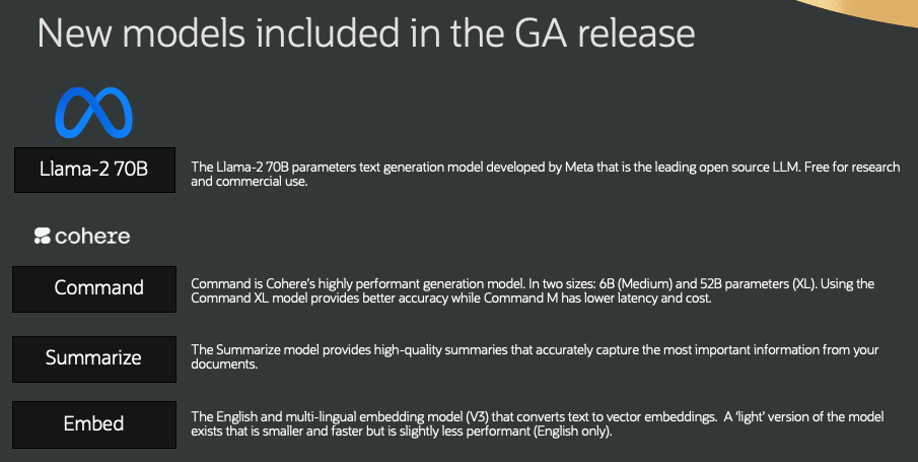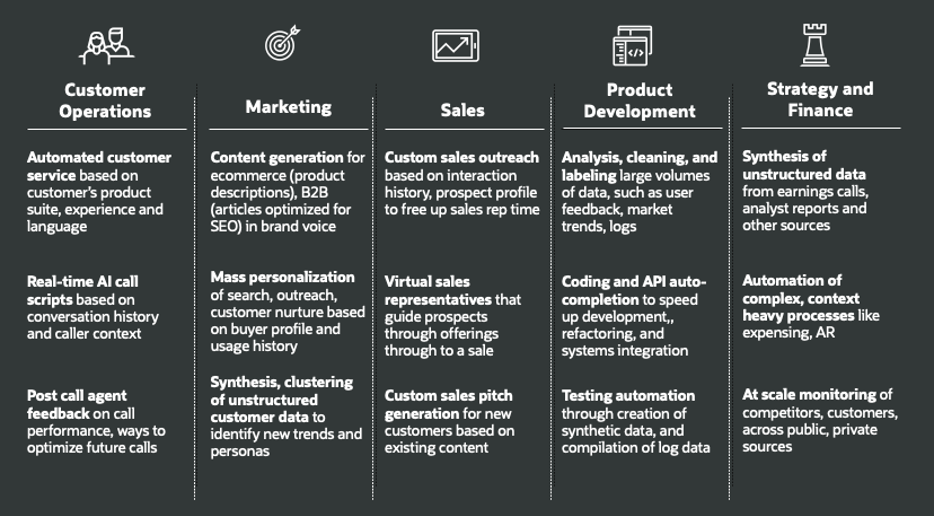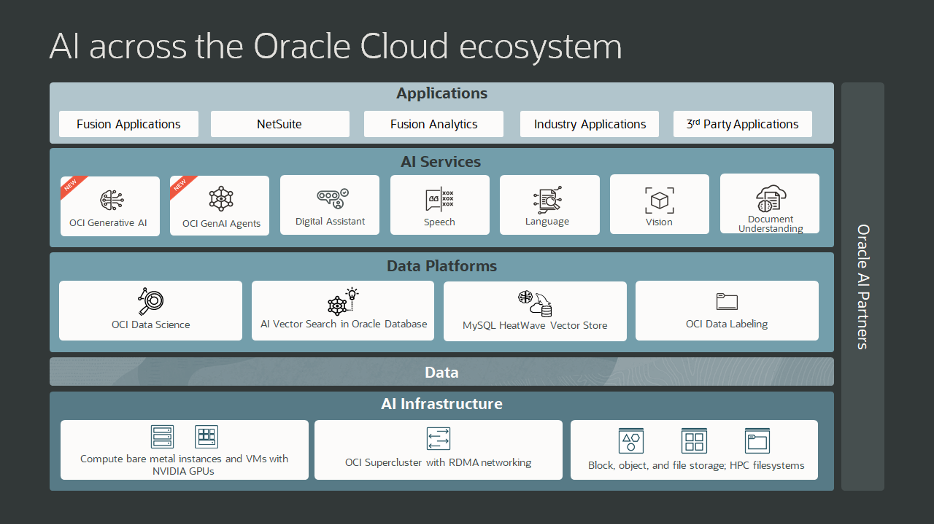Last week Oracle announced Oracle Cloud Infrastructure Generative AI, a service that aims to embed generative AI across the enterprise. This service, leveraging large language models from Cohere and Meta, is designed to be infused into the different workloads that power a business.
In the following sections, I’ll explain the details of the OCI Generative AI service, what it means for enterprises, and how it is positioned competitively.
What was announced
Oracle announced three new generative AI offerings to complement the AI capabilities it has already infused across the stack: OCI Generative AI, OCI Generative AI Agents, and OCI Data Science AI Quick Actions.
OCI Generative AI (general availability)
This service is the heart of what has been released for use by customers. It comprises multiple LLMs fully hosted in OCI to enable generative AI across a business. Further, these models are private and secure—meaning that customer training and inference data is accessible only by the customer. In fact, customer data is not only secure from other OCI customers, but also from the LLM providers (Meta and Cohere).

Drilling down a little more, it’s worth exploring the three models provided by Cohere, as I believe they demonstrate how broadly OCI Generative AI can benefit a business. The Command model follows user instructions and generates a textual response. This is used for responding to general questions and extracting information from documents. The Summarize model is all about summarizing complex documents, boiling them down to key points. Meanwhile, the Embed model converts texts into vectors to enable semantic search. Consider a tech company with a vast knowledge base, in which a junior support rep is trying to find the correct answer to a customer problem. Semantic search capabilities enable that rep to find the relevant answer faster.
The Meta Llama-2 model is a popular open-source model focusing on text generation (like Cohere Command) and finely tuned for chatbot integration. While I am not making any recommendations, the intended audience is the significant difference between the two. Cohere is an enterprise-first vendor, while Meta has a broader support base.
I like that what Oracle has rolled out takes into account the many use cases that exist in an enterprise. There is a lot of “GenAI for GenAI’s sake” in the market. But it’s easy to rush a service to market without real consideration about how an organization will leverage it. Oracle has not done this, and because of its approach, I believe there will be strong adoption.

The entire business world has jumped on the AI hype bandwagon. However, enterprise adoption is still lagging. And, really, it’s no surprise. Anecdotally, I can say that IT executives I speak with are being cautious and measured. They’re being careful because there are a lot of challenges and questions around how to use AI in different use cases for the business. And they’re being intentional about understanding how to align the many moving parts (technical and business) for preparing data for the AI transformation.
These discussions further confirm my belief in OCI’s strategy. Given the approach Oracle is taking, organizations can pace their AI transformations according to the willingness and readiness of each business unit to adopt AI.
OCI Generative AI Agents (in beta)
Generative AI agents are a set of interfaces that, in simple terms, make it far easier for organizations to democratize the use of the enterprise’s data. The first of these is a retrieval-augmented generation (RAG) service through which a user asks a complex question in natural language, and the RAG service calls an OpenSearch instance to check all accessible data across the enterprise so it can retrieve, synthesize, and return relevant results.
Like the OCI Generative AI service, OCI Generative AI agents seem to be focused on delivering practical value to business users specifically and to the business as a whole. The OCI team has talked about RAG being the first of many such services that will help streamline the adoption and use of OCI Generative AI. I’ll be keeping an eye on the releases of other agents.
OCI Data Science AI Quick Actions (in beta)
This service aims to simplify the deployment of open source LLMs. With literal point-and-click simplicity (i.e., no code), data scientists can set up and fine-tune a curated selection of LLMs. Again, this is an example of how to better enable AI across the enterprise.
In addition to the availability of these LLMs, OCI has built additional AI capabilities into some of its existing services. For example, the OCI Language Healthcare NLP performs natural language processing for the medical domain by better recognizing medical terms and relationships among clinical trial notes, patient notes, and electronic health records. This speaks directly to AI’s real and pragmatic use to deliver better outcomes.
Why all of this matters to enterprise IT
When I was an IT executive, I would walk out of every meeting with business leaders with a mandate to implement the hottest tech trend or else. So the pressure to jump on technology trends is nothing new.
However, generative AI is different in some ways because of how it connects relevant data to business units and users. There is a lot of power in this if it is deployed and managed properly. But the complexity of generative AI is also why enterprise-wide adoption lags.

What Oracle (and OCI) is doing by infusing AI across all of the applications and services it offers—and tightly integrating all of these capabilities—is making life much easier for IT organizations struggling with how to make AI real, relevant, and valuable for the organization without having to double the staff or infrastructure budget.
Final thoughts
I like the moves Oracle has made to build AI into everything. And I like what OCI is doing with its most recent announcements. While some impatient types may have wanted these services (and more) sooner, I believe that OCI is doing things the right way by delivering services that have genuine utility in the enterprise.
Given Oracle’s prominent role in the enterprise data management market, I expect strong adoption of the OCI Generative AI service. It only makes sense that the vendor I’ve trusted with my enterprise data is the company I would turn to so I can derive greater value from all that data.
I’ll be watching to see how Oracle’s strategy continues to unfold as it enables AI in the cloud for enterprises. Stay tuned.
























































































